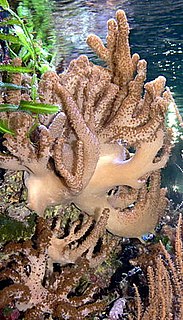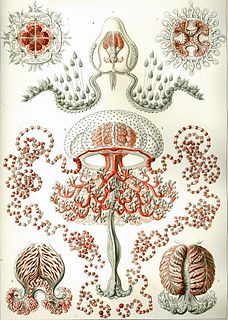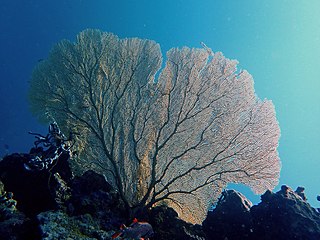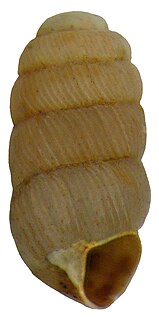
The Scorpaeniformes are a diverse order of ray-finned fish, including the lionfishes and sculpins, but have also been called the Scleroparei. It is one of the five largest orders of bony fishes by number of species, with over 1,320.

The Osmeriformes are an order of ray-finned fish that includes the true or freshwater smelts and allies, such as the galaxiids and noodlefishes; they are also collectively called osmeriforms. They belong to the teleost superorder Protacanthopterygii, which also includes pike and salmon, among others. The order's name means "smelt-shaped", from Osmerus + the standard fish order suffix "-formes". It ultimately derives from Ancient Greek osmé + Latin forma, the former in reference to the characteristic aroma of the flesh of Osmerus.

The Atheriniformes, also known as the silversides, are an order of ray-finned fishes that includes the Old World silversides and several less-familiar families, including the unusual Phallostethidae. The order includes at least 354 species. They are found worldwide in tropical and temperate marine and freshwater environments.

Isopoda is an order of crustaceans that includes woodlice and their relatives. Isopods live in the sea, in fresh water, or on land. All have rigid, segmented exoskeletons, two pairs of antennae, seven pairs of jointed limbs on the thorax, and five pairs of branching appendages on the abdomen that are used in respiration. Females brood their young in a pouch under their thorax.

The Hyperiidea are a suborder of amphipods, small aquatic crustaceans. Unlike the other suborders of Amphipoda, hyperiids are exclusively marine and do not occur in fresh water. Hyperiids are distinguished by their large eyes and planktonic habitat. Most species of hyperiids are parasites or predators of salps and jellyfish in the plankton, although Themisto gaudichaudii and a few relatives are free-swimming predators of copepods and other small planktonic animals.

Alcyonacea, or soft corals, are an order of corals. In addition to the fleshy soft corals, the order Alcyonacea now contains all species previously known as "gorgonian corals", that produce a more or less hard skeleton, though quite different from "true" corals (Scleractinia). These can be found in suborders Holaxonia, Scleraxonia, and Stolonifera. They are sessile colonial cnidarians that are found throughout the oceans of the world, especially in the deep sea, polar waters, tropics and subtropics. Common names for subsets of this order are sea fans and sea whips; others are similar to the sea pens of related order Pennatulacea. Individual tiny polyps form colonies that are normally erect, flattened, branching, and reminiscent of a fan. Others may be whiplike, bushy, or even encrusting. A colony can be several feet high and across, but only a few inches thick. They may be brightly coloured, often purple, red, or yellow. Photosynthetic gorgonians can be successfully kept in captive aquaria.

Heteroconchia is a taxonomic infraclass of saltwater clams, marine bivalve molluscs, belonging to the subclass Autobranchia

Anthoathecata, or the athecate hydroids, are an order of hydrozoans belonging to the phylum Cnidaria. A profusion of alternate scientific names exists for this long-known, heavily discussed, and spectacular group. It has also been called Gymnoblastea and, Anthomedusa,Athecata, Hydromedusa, and Stylasterina. There are about 1,200 species worldwide.

The Euctenidiacea, common name dorid nudibranchs, are a taxonomic suborder of sea snails or slugs, marine gastropod molluscs in the order Nudibranchia. Bouchet & Rocroi (2005) rejected the name Anthobranchia on the grounds that it also included Onchidium at the time of original publication. Doridina is equivalent and used in the latest classification.

Artiofabula is a clade made up of the Suina and the Cetruminantia. The clade was found in molecular phylogenetic analyses and contradicted traditional relationships based on morphological analyses.

Phyllodocida is an order of polychaete worms in the subclass Aciculata. These worms are mostly marine though some are found in brackish water. Most are active benthic creatures, moving over the surface or burrowing in sediments, or living in cracks and crevices in bedrock. A few construct tubes in which they live and some are pelagic, swimming through the water column. There are estimated to be about 3,500 species in the order.

Scleraxonia is a suborder of corals, a member of the phylum Cnidaria.

Spionida is an order of marine polychaete worms in the infraclass Canalipalpata. Spionids are cosmopolitan and live in soft substrates in the littoral or neritic zones.

Holaxonia is a suborder of soft corals, a member of the phylum Cnidaria. Members of this suborder are sometimes known as gorgonians and include the sea blades, the sea fans, the sea rods and the sea whips. These soft corals are colonial, sessile organisms and are generally tree-like in structure. They do not have a hard skeleton composed of calcium carbonate but have a firm but pliable, central axial skeleton composed of a fibrous protein called gorgonin embedded in a tissue matrix, the coenenchyme. In some genera this is permeated with a calcareous substance in the form of fused spicules. Members of this suborder are characterized by having an unspiculated axis and often a soft, chambered central core. The polyps have eight-fold symmetry and in many species, especially in the families Gorgoniidae and Plexauridae, contain symbiotic photosynthetic algae called zooxanthellae. These soft corals are popular in salt water aquaria.

Capitata is a suborder of Hydrozoa, a class of marine invertebrates belonging to the phylum Cnidaria.

Filifera is a suborder of hydrozoans in the order Anthoathecata. They are found in marine, brackish and freshwater habitats.

Aplanulata is a suborder of Hydrozoa, a class of marine and freshwater invertebrates belonging to the phylum Cnidaria. The group have lost its planula larval stage, and the only remnants of the medusa stage is when they functions as gonophores attached to the polyp.

Corymorphidae is a family of hydroid cnidarians. For long placed in a presumed superfamily or infraorder Tubulariida of suborder Capitata, they are actually close relatives of the Hydridae and are now united with these and a number of relatives in a newly recognized suborder Aplanulata. Most, if not all species in this family grow on stalks and resemble small flowers.

After excluding groups not related, the informal group Sigmurethra has become the suborder Helicina, with the following infraorders and a collection of families with no superfamily:

The Pupilloideiis an taxonomic infraorder of air-breathing land snails, semislugs and slugs, terrestrial pulmonate gastropod molluscs in the suborder Helicina.




















